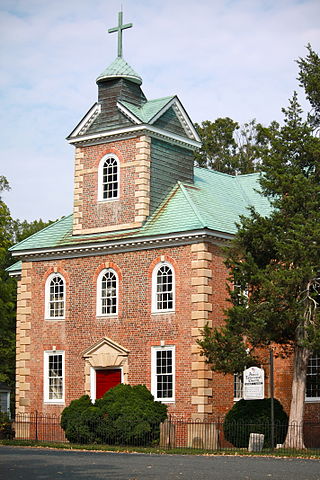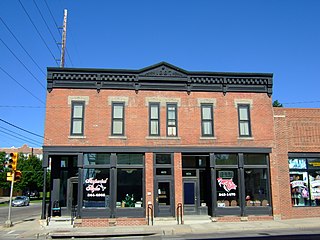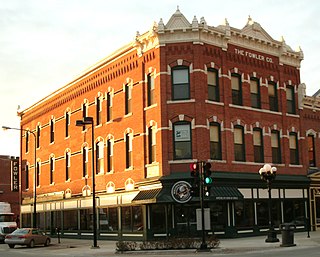
Fredericksburg and Spotsylvania National Military Park is a unit of the National Park Service in Fredericksburg, Virginia, and elsewhere in Spotsylvania County, commemorating four major battles in the American Civil War: Fredericksburg, Chancellorsville, The Wilderness, and Spotsylvania.

Double Trouble State Park is located in Berkeley and Lacey Townships in Ocean County, in the U.S. state of New Jersey. The park was once the Double Trouble company's company town. The park's wilderness is part of the Pine Barrens ecosystem. The park is operated and maintained by the New Jersey Division of Parks and Forestry.

Aquia Church is a historic church and congregation at 2938 Richmond Highway in Stafford, Virginia, USA. It is an Episcopal congregation founded in 1711, that meets in an architecturally exceptional Georgian brick building that was built in the 1750s. The building was designated a National Historic Landmark in 1991 for its architectural importance. It maintains an active congregation with a variety of programs and outreach to the community.

Stafford Hollow, also known as Stafford, Stafford Village, or Furnace Hollow, is a village in the town of Stafford, in Tolland County, Connecticut, located at the junction of Route 19 and Route 319. Stafford Hollow was the town center of Stafford during the 18th and 19th centuries, before the growth of the village of Stafford Springs.

Brammer Grocery Store is a historic building located in the West End of Davenport, Iowa, United States. The building was listed on the National Register of Historic Places in 1983. The two-story, brick, Greek Revival style building is an example of a traditional local house form adapted to small-scale commercial use. It features a plain façade, a diamond-shaped light in the gable, and keystones over the second floor windows. John Brammer opened Brammer and Son, a grocery store, in this building in 1885. He joined with Louis Ott in 1895 and they added hardware and paint to their offerings. The store was renamed Brammer and Ott. The building has subsequently housed other business ventures over the years.

Werthman Grocery is located at a commercial intersection in a residential neighborhood in the West End of Davenport, Iowa, United States. While it initially housed a grocery store, the building has been a long time neighborhood tavern. It was listed on the National Register of Historic Places in 1984.

Grand Forks Mercantile Company is a property in Grand Forks, North Dakota that was listed on the National Register of Historic Places in 1982. Built in 1893, the building includes Early Commercial and Italianate architecture.

The Baker-Devotie-Hollingsworth Block is a historic building located in the East Village of Des Moines, Iowa, United States. The eastern two-thirds of the block was listed on the National Register of Historic Places in 1978 as the Studio Building. The western one-third was added to the National Register in 2008, and its name was changed at that time. In 2019 the entire building was included as a contributing property in the East Des Moines Commercial Historic District.

The Wherry Block, also known as Wherry's Hall, Scruby Brothers Grocery, and Scruby's Grocery Store, is a historic building located in Des Moines, Iowa, United States.

The Milk Bottle Grocery, located at 2426 N. Classen Boulevard in Oklahoma City, Oklahoma, is a grocery building with a large metal Braum's milk bottle atop its roof. The store was constructed in 1930, and the milk bottle was added in 1948. The bottle was designed to draw attention to the store, as the tall bottle would be visible to automobile traffic along Classen Boulevard, which was part of U.S. Route 66 at the time; it also served as an advertisement for the dairy industry. The store is also one of the few triangular buildings in Oklahoma City, as it occupies a corner lot in an area where Classen Boulevard cuts diagonally through the city's street grid. Due to its shape, the store was known as the Triangle Grocery from 1940 until 1948, when it became the Milk Bottle Grocery due to its new statue.
The D.H. Anderson Building, also known as the Sue's Hallmark Store, was a historic building located in Maquoketa, Iowa, United States. The three-story brick building was built in 1882 by Dr. Galloway Truax, a local druggist. The grocery firm of D. H. Anderson initially occupied the first-floor commercial space, and Anderson bought the building in 1888. It remained in the family until 1956. A lawyer and the Knights of Pythias occupied the second floor, and the Masons occupied the third floor. The building had an unusual gable roof to accommodate the Masons' desire for a vaulted ceiling. After the Masons moved out in 1902, the Knights of Pythias occupied the third floor until 1957. Various retail establishments occupied the first-floor retail space. The building was damaged in a 1971 fire. It was listed on the National Register of Historic Places in 1986.

The Building at 130–132 North Riverview Street is a historic commercial building located in Bellevue, Iowa, United States. It is one of over 217 limestone structures in Jackson County from the mid-19th century, of which 20 are commercial buildings. The 2½-story structure was built around 1855 to house retail establishments, which have included dry goods, a grocery, clothing and footwear stores, and a tavern. The double storefront building features three bays on both sides. The stone blocks used in its construction vary somewhat in shape and size, and they were laid in courses. It also features dressed stone lintels. The storefronts were altered in the late 19th and early 20th centuries, but they retain their original limestone piers. What differentiates this building from the others is the gable roof. The second floor balcony on the south half of the building is a recent addition. It storefront has also been altered again in more recent years. The building was listed on the National Register of Historic Places in 1991.

The Progressive Market is a historic commercial building at 63 South Main Street in White River Junction, Vermont. Built in 1922, it is an example of an increasingly rare type of building in Vermont, the neighborhood market. The store was operated for many years by Italian immigrants and Italian Americans, serving a local community in the area south of downtown White River Junction. The building, largely vernacular in form, was listed on the National Register of Historic Places in 1995. it appears to no longer house a retail establishment.

The Downtown Essex Junction Commercial Historic District encompasses the historically railroad-dominated portion of downtown Essex Junction, Vermont. Aligned along the south side of Railroad Avenue and adjacent portions of Main Street, the area underwent most of its development between 1900 and 1940, when Essex Junction served as a major regional railroad hub. The district was listed on the National Register of Historic Places in 2004.

The Albertus Building, also known as the Gutenberg Haus, is a historic building located in Guttenberg, Iowa, United States. The two-and three-story structure of locally quarried limestone was completed around 1855 by C. Albertus. A unique feature of the building are the pointed arch doorways and windows, which have not been found on similar commercial buildings in Iowa. The building was initially used for a combination of commercial and residential use. Clothing and grocery stores were located on the first floor of the southern three-story block. By 1886 the northern two-story block was all residential, and by 1894 the whole building had gone residential.
Maynard Town Hall and Jail is a historic building located in Maynard, Iowa, United States. Before this building was constructed the town had no building to enact its business. They used the mayor's house or place of business for his office and council meetings. After it was completed, this building served as a jail into the late 1930s and as the city hall until 1952, when a new community building was completed. For most of the time it served as a jail it was outfitted with bars and had bunks. It was a short-term lock-up for those who committed minor infractions. It was used for a public library beginning in the 1940s. After its use as a city hall, it was bought by a local merchant for use in his grocery store in 1957. The building was listed on the National Register of Historic Places in 1997.

The Fowler Company Building is a historic building located in Waterloo, Iowa, United States. It was built in 1884 by the city's most successful grocery wholesale business. They continued to operate from here until 1937. The three-story brick structure is an example of Late Victorian commercial architecture with Queen Anne influences. The building features pilasters, corbeling, canted-brick courses, and contrasting stone trim around and between the windows and at the street level. It is capped with an ornate metal cornice that contains pilasters, finials, pediments, floral and circle imagery, and quilted surface textures. It was individually listed on the National Register of Historic Places in 2009. In 2011 it was included as a contributing property in the Waterloo East Commercial Historic District.

The Saltus Grocery Store is a historic mixed-use commercial and residential building at 299-301 North Winooski Street in Burlington, Vermont. Built in 1897, it is a well-preserved example of a neighborhood store of the period. It was listed on the National Register of Historic Places in 2001.

The Burnstein-Malin Grocery, also known as the Malin's Kosher Delicatessen, Pickle Barrel Delicatessen, and The Pickle Barrel, was a historic building located in Des Moines, Iowa, United States. This commercial building was constructed in two parts. The first part was a 2½-story frame house built back from Sixth Avenue for Frank W. Whitcomb in 1896. It was converted into Burnstein Grocery in 1923. The number of commercial establishments along this street increased five-fold between 1920 and 1937, and the Whitcomb house exemplified this transition. The single-story brick section on the front was completed in 1940. The two sections shared a common wall. This was one of several modified residence-specialty stores that were located along Sixth Avenue from the 1930s through the 1950s, but by the end of the century it was only one of two that remained standing. The building was listed on the National Register of Historic Places in 1998. It has subsequently been torn down and it was delisted from the National Register in 2019.

The Western Union Building, formerly known as the Hagerty Block and currently as the Dacotah Prairie Museum, is a historic bank building in Aberdeen, South Dakota. It is individually listed on the National Register of Historic Places and is a contributing property to the Aberdeen Commercial Historic District.




















